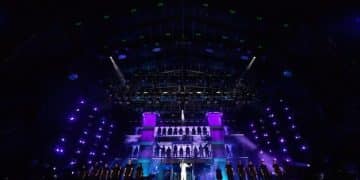The Power of Fandom: Shaping Entertainment’s Future

The power of fandom intricately weaves through the entertainment industry, transforming passive consumers into active co-creators who profoundly influence content creation, marketing strategies, and revenue streams, ultimately redefining engagement.
In an increasingly interconnected world, The Power of Fandom: How Passionate Fans Are Shaping the Entertainment Industry has become an undeniable force. Once relegated to niche communities, fan engagement now drives narratives, influences production decisions, and reshapes the very economic models of entertainment. This profound shift extends beyond mere consumption, spotlighting how dedicated communities are becoming indispensable stakeholders in the success and evolution of their beloved franchises.
The Evolution of Fandom: From Passive Viewers to Active Participants
Fandom has undergone a radical transformation. What began as a relatively passive act of consumption—watching a show, reading a book, or attending a concert—has blossomed into a dynamic, interactive ecosystem. Modern fans are no longer content with merely observing; they demand to be heard, to contribute, and to engage actively with the content and creators they admire. This evolution is underpinned by technological advancements, particularly the rise of social media and dedicated online platforms, which have dismantled traditional communication barriers between creators and audiences.
The advent of the internet provided nascent fan communities with unprecedented tools for connection and organization. Forums, message boards, and early social networking sites allowed enthusiasts to converge, share theories, create fanworks, and collectively amplify their voices. This digital infrastructure laid the groundwork for the powerful, influential fandoms we see today, capable of driving trends, influencing critical reception, and even altering the course of a popular narrative. The shift is so profound that it compels entertainment executives to listen closely, understanding that ignoring fan sentiment can be a precarious gamble in a rapidly changing market.
The Digital Crucible of Community
Social media platforms have been pivotal in this transformation, acting as vibrant crucibles where fandoms coalesce and amplify their collective power. These platforms provide immediate channels for feedback, discussion, and content sharing, fostering a sense of belonging and urgency among fans. The ability to directly interact with creators, fellow fans, and even the official accounts of studios and networks has blurred the lines between audience and producer, creating a more symbiotic relationship.
- Instant Feedback Loops: Fans can provide real-time reactions to content, influencing future storylines or character developments.
- Global Connectivity: Geographic boundaries dissolve, allowing fans from disparate regions to unite over shared passions.
- Content Aggregation: Platforms centralize fan art, fan fiction, theories, and discussions, creating rich archives of community-generated content.
- Campaign Mobilization: Social media is a powerful tool for organizing fan campaigns, whether to save a canceled show or advocate for specific changes.
This digital evolution is not without its complexities. While empowering, it also opens avenues for intense scrutiny and, at times, divisive debates. Yet, the overall trend points to a more engaged and vocal audience, one that demands authenticity and responsiveness from the entertainment industry.
Fan Influence in Content Creation and Storytelling
The impact of passionate fans extends directly into the very fabric of content creation and storytelling. No longer is the creative process a one-way street from studio to audience; it’s increasingly a collaborative conversation. Fan theories, desires, and even criticisms are now frequently considered by writers, directors, and producers, sometimes leading to tangible changes in narratives or character arcs. This responsiveness demonstrates a growing recognition within the industry that audience engagement isn’t just about viewership numbers, but about fostering a loyal, invested community.
Examples abound, from TV shows that alter plot points based on online discussions to movie studios gauging fan reaction to trailers before committing to final cuts. This iterative feedback loop can refine storytelling, making it more resonant with the core audience, or occasionally, navigating away from elements that might alienate them. It requires a delicate balance for creators: acknowledging fan input without sacrificing their artistic vision or becoming overly reactive to every vocal minority.
Shaping Narratives and Character Arcs
The collective voice of a fandom can significantly influence the trajectory of a story. Writers’ rooms often monitor fan forums, Twitter trends, and Reddit threads to gauge audience sentiment on characters, relationships, and plot developments. While not every suggestion can be implemented, recurring themes or overwhelmingly popular ideas sometimes find their way into official canon. This can lead to more satisfying experiences for the audience, reinforcing their sense of ownership and connection to the content.
- Character Development: Fan petitions or strong reactions can push for more screen time for beloved characters or influence their personal journeys.
- Relationship Building: “Shipping” culture often drives creators to consider or even formalize romantic or platonic pairings requested by fans.
- Plot Twists: Well-articulated fan theories can either be validated, adding a layer of meta-engagement, or deliberately subverted, showing creators are aware of fan speculation.
This dynamic interplay ensures that the stories remain fresh and relevant, evolving in tandem with their dedicated audiences. For creators, it’s an opportunity to deepen the connection, while for fans, it’s a testament to their collective power to influence the stories they love.

The Economic Power of Fandom: Driving Revenue and Merchandising
Beyond creative influence, fans represent a formidable economic force. Their passion translates directly into significant revenue streams, powering everything from box office success and streaming subscriptions to colossal merchandising empires. Studios and creators have long understood the value of a dedicated fanbase, but in the modern era, this value has multiplied, making fan loyalty a critical business asset. Fandoms don’t just consume; they evangelize, they collect, and they invest deeply, literally and figuratively, in their chosen franchises.
This economic impact is multifaceted. For films, it means repeat viewings and strong opening weekends. For television, it translates into sustained viewership, driving advertising revenue and subscription numbers. But perhaps most visibly, the economic power of fandom manifests in the burgeoning market for licensed merchandise, collectibles, and experiential events. Fans are willing to spend significant amounts to express their devotion, whether it’s through apparel, action figures, themed experiences, or even direct crowdfunding of projects.
Merchandising and Collectibles
The link between fandom and merchandising is symbiotic. High-quality merchandise serves as a tangible expression of fan identity, allowing individuals to proudly display their allegiance to a franchise. This demand fuels an enormous industry, ranging from mass-produced items available in major retailers to highly sought-after, limited-edition collectibles. The market for merchandise often far outstrips initial content revenues, securing the longevity and profitability of a given brand.
- Licensed Products: Apparel, toys, home goods, and stationery branded with franchise logos and characters.
- Limited Editions: Highly collectible items that drive scarcity and increase perceived value among dedicated fans.
- Exclusives: Merchandise unique to specific events (e.g., Comic-Con) or online retailers, encouraging attendance and engagement.
This segment of the industry thrives on fan desire to own a piece of their beloved universe, turning abstract emotional connection into concrete economic activity.
Events and Experiential Fandom
The desire for deeper engagement also drives the success of fan conventions, themed attractions, and interactive experiences. Events like Comic-Con, Star Wars Celebration, or specialized expos generate substantial revenue through ticket sales, vendor booths, and exclusive merchandise. These gatherings provide a unique space for fans to connect with each other, meet creators, and immerse themselves in the world of their favorite stories. They are powerful hubs that reinforce community, generate buzz, and celebrate shared passions.
Fan Activism and Advocacy: Directing Industry Decisions
Modern fandom is not just about passive consumption or even active participation; it often morphs into powerful advocacy and activism. Fans, fueled by deep emotional investment, are increasingly willing to mobilize and advocate for causes directly tied to their favorite franchises. This can range from campaigning to save a beloved but struggling TV show to demanding greater inclusivity in casting, or even boycotting productions over perceived injustices or creative missteps. Their collective voice, amplified by social media, can exert significant pressure on studios, networks, and creators, influencing major industry decisions.
This phenomenon indicates a shift in power dynamics, where audiences are no longer just targets of marketing but moral and creative watchdogs. While this can sometimes lead to intense and even controversial campaigns, it also represents an unparalleled level of accountability for the entertainment industry. The fear of alienating a passionate fanbase can be a strong deterrent against unpopular creative choices or decisions perceived as disrespectful to the source material or its community.
Crowdfunding and Fan-Driven Projects
Beyond traditional activism, fans have also demonstrated their power by directly funding projects they believe in. Crowdfunding platforms have enabled fans to bypass traditional studio gatekeepers, directly supporting creators or even reviving dormant franchises. This financial activism empowers creators with creative freedom and allows fans to have a direct stake in the production of content they genuinely desire. It underlines a proactive desire to see specific stories told, rather than waiting for established institutions to greenlight them.
- Funding Revivals: Campaigns to bring back cancelled shows or produce new installments of beloved properties.
- Supporting Indie Creators: Helping independent artists, writers, and filmmakers bring their fan-inspired concepts to fruition.
- Merchandise Development: Funding the creation of exclusive, high-quality fan-made merchandise or collectibles.
This tangible support is a clear indicator of fan commitment and a powerful signal to the industry about unmet demands.
Demanding Representation and Inclusivity
One of the most impactful forms of fan activism revolves around demands for greater representation and inclusivity in media. Fandoms, often diverse themselves, are vocal proponents of seeing characters that reflect a broader spectrum of identities, including different ethnicities, sexual orientations, gender identities, and abilities. When studios fail to deliver, or worse, mishandle existing representation, fans often react swiftly and powerfully, using their collective voice to call for change and holding creators accountable for their portrayals. This pressure has undeniably contributed to a slow but discernible shift towards more diverse and authentic storytelling across the industry.
Challenges and Criticisms of Powerful Fandoms
While the power of fandom undeniably brings immense benefits to the entertainment industry, it also introduces a unique set of challenges and criticisms. The very passion that drives positive engagement can, at times, turn into a stifling force, creating environments that are less about collaboration and more about control or even hostility. Navigating this complex landscape requires a delicate touch from creators and industry professionals, balancing the desire to satisfy fans with the imperative to maintain creative integrity and fostering a respectful discourse.
One of the primary concerns is the potential for toxicity within passionate communities. The anonymity of the internet can embolden a vocal minority to engage in harassment, bullying, or aggressive gatekeeping, targeting creators, fellow fans, or even actors when their expectations are not met or their favorite interpretations are challenged. This can create an unwelcoming atmosphere, deter new fans, and even lead to creators withdrawing from public engagement. For the industry, managing these extreme elements without alienating the broader, healthier fanbase is a constant tightrope walk.
Creative Constraints and Backlash
The constant scrutiny and immediate feedback from powerful fandoms can inadvertently place creative constraints on artists. The fear of online backlash, or “fan rage,” can lead creators to pull punches, avoid controversial but potentially compelling storylines, or adhere too strictly to established fan expectations rather than venturing into innovative or challenging territory. This can result in risk-averse storytelling, where narratives prioritize pleasing a vocal segment of the audience over artistic boldnes or unexpected developments that might ultimately enrich the story.
- Narrative Stagnation: Creators might become hesitant to introduce significant changes or character departures if they anticipate negative fan reactions.
- Actor Harassment: Performers can face personal attacks or online bullying if their portrayal deviates from fan expectations or if they are associated with storylines that fans dislike.
- “Gatekeeping”: Certain fan segments may attempt to dictate what constitutes “true” fandom, leading to exclusion and negativity towards newcomers or those with different interpretations.
This dynamic highlights the fine line between collaborative feedback and creative overreach, emphasizing the need for creators to maintain their artistic vision while still valuing their audience.
Managing Expectations and Entitlement
Another significant challenge lies in managing fan expectations and the sense of entitlement that can sometimes emerge within highly invested communities. When fans feel a deep personal connection to a franchise, they may also believe they have a proprietary right to its direction, often forgetting that the intellectual property ultimately belongs to the creators and studios. This can lead to disproportionate reactions when creative decisions don’t align with their personal desires—from petitions to reshoot entire seasons to aggressive campaigns against writers or showrunners. Striking a balance between valuing fan input and asserting creative autonomy is crucial for the long-term health of any franchise.
The Future of Fandom: Co-Creation and Emerging Platforms
The landscape of fandom is perpetually evolving, hinting at a future where co-creation becomes even more integrated into the entertainment industry’s DNA. Emerging technologies and changing audience behaviors are paving the way for unprecedented levels of engagement, blurring the lines further between content producers and consumers. This next phase of fandom promises more immersive experiences, personalized interactions, and collaborative storytelling initiatives that were once the exclusive domain of professional studios.
Foreseeing this future involves recognizing the accelerating trend towards interactive media, virtual experiences, and decentralized content creation. The metaverse, Web3 technologies, and sophisticated AI tools are not just buzzwords; they represent potential new playgrounds for fandom, offering novel ways for fans to shape narratives, build their own adjacent worlds, and participate in truly collaborative projects. The industry that embraces these shifts will be best positioned to harness the full, enduring power of its most passionate supporters.
Interactive Storytelling and Immersive Experiences
From choose-your-own-adventure narratives on streaming platforms to augmented reality games that extend beloved fictional worlds into real-life environments, interactive storytelling is increasingly becoming a staple. This allows fans to directly influence outcomes, make decisions for characters, and experience narratives in deeply personal ways. The future likely holds even more sophisticated forms of this, where fan choices might genuinely alter canon or lead to entirely new story branches generated or influenced by collective fan input.
- Gamified Narratives: Incorporating elements of gaming into traditional storytelling, allowing player (fan) agency.
- Virtual and Augmented Reality: Creating immersive spaces where fans can step into their favorite fictional worlds and interact with them firsthand.
- Community-Driven Content: Platforms that facilitate fans creating and sharing interactive experiences based on existing IPs.
These developments promise a more active and less passive form of entertainment consumption.
Fan-Generated Content and IP Licensing
The vast amount of high-quality fan-generated content—fan fiction, fan art, fan films, and music—represents an enormous, largely untapped creative reservoir. In the future, we may see more formal mechanisms for intellectual property (IP) holders to collaborate with, or even financially support, fan creators. This could involve licensing agreements that allow fans to monetize their derivative works or official platforms where the best fan-created content is showcased and potentially integrated into wider franchise canons. This approach acknowledges the profound artistry and dedication within fandom and transforms a historically complex relationship into a mutually beneficial partnership, fostering an ecosystem where fan creativity genuinely fuels brand longevity and growth. The implications for talent discovery and diversified content are profound, signaling a new era of open collaboration.
Conclusion: The Indispensable Role of Fandom
The journey of fandom, from quiet appreciation to a dynamic force actively shaping the entertainment landscape, underscores an undeniable truth: passionate fans are no longer peripheral; they are central. Their influence permeates every facet of the industry, from dictating narrative turns and driving economic success through merchandise and events, to instigating powerful activist movements that demand greater accountability and representation. While presenting challenges like managing expectations and avoiding creative stagnation, the benefits of deeply engaged communities far outweigh these complexities. As technology continues to evolve, facilitating even deeper levels of interaction and co-creation, the power of fandom will only grow, solidifying its indispensable role in the future of entertainment. For creators and studios, understanding, respecting, and strategically collaborating with fan communities will not just be good practice, but a requisite for enduring relevance and success.
| Key Aspect | Brief Description |
|---|---|
| 💬 Fan Influence | Fans actively shape narratives, character arcs, and even production decisions. |
| 💰 Economic Impact | Drives revenue through merchandise, events, and sustained viewership. |
| ✊ Activism & Advocacy | Mobilizes for change, demanding representation and influencing industry ethics. |
| 🔮 Future Trends | Moving towards increased co-creation, interactive stories, and licensed fan content. |
Frequently Asked Questions About Fandom’s Influence
▼
Fans influence content through direct feedback on social media, participation in online forums, and creation of fanworks. This collective sentiment often informs creators’ decisions on character development, plot adjustments, and even the continuation or revival of series, demonstrating a responsive loop between audience and production.
▼
Passionate fandoms are significant economic drivers, contributing through direct purchases of tickets, streaming subscriptions, and extensive merchandising. Their active engagement creates sustained interest, leading to strong sales of licensed products and high attendance at fan conventions, boosting overall franchise profitability.
▼
Yes, fan activism can genuinely change industry decisions. Examples include successful campaigns to save canceled shows, powerful calls for greater diversity and representation in casting and storylines, and organized boycotts that pressure studios into reconsidering projects or creative directions, showcasing their collective power.
▼
Challenges include the potential for toxic behavior like harassment and gatekeeping, which can deter new fans or creators. Powerful fandoms can also unintentionally place creative constraints on artists due to fear of backlash, potentially leading to risk-averse storytelling or a perceived sense of entitlement among certain fan segments.
▼
Fandom is expected to evolve towards more integrated co-creation and immersive experiences through emerging technologies. This includes interactive storytelling, virtual and augmented reality applications that allow deeper narrative participation, and formal IP licensing models that empower fans to monetize their creative input, fostering true collaborative content creation.
Conclusion
The journey of fandom, from quiet appreciation to a dynamic force actively shaping the entertainment landscape, underscores an undeniable truth: passionate fans are no longer peripheral; they are central. Their influence permeates every facet of the industry, from dictating narrative turns and driving economic success through merchandise and events, to instigating powerful activist movements that demand greater accountability and representation. While presenting challenges like managing expectations and avoiding creative stagnation, the benefits of deeply engaged communities far outweigh these complexities. As technology continues to evolve, facilitating even deeper levels of interaction and co-creation, the power of fandom will only grow, solidifying its indispensable role in the future of entertainment. For creators and studios, understanding, respecting, and strategically collaborating with fan communities will not just be good practice, but a requisite for enduring relevance and success.





